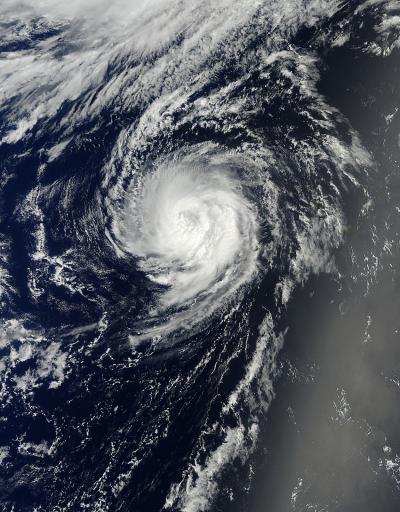NASA sees Tropical Storm Julio now far from Hawaii

On Aug. 13 at 21:10 UTC (5:10 p.m. EDT), the MODIS instrument aboard NASA's Terra satellite captured this visible image of Hurricane Julio moving through the Central Pacific Ocean. Credit: NASA Goddard MODIS Rapid Response Team
Julio is far enough away from Hawaii so that there are no coastal watches or warnings in effect.
On August 13 at 21:10 UTC (5:10 p.m. EDT), the Moderate Resolution Imaging Spectroradiometer of MODIS instrument aboard NASA's Terra satellite captured a visible image of Hurricane Julio moving through the Central Pacific Ocean.
The visible image shows that powerful thunderstorms still circled the center of the storm, and that Julio still had an eye, although somewhat obscured by clouds.
Bands of thunderstorms continued to wrap into the center of circulation from the eastern side of the storm.
On August 14 at 5 a.m. HST (11 a.m. EDT/1500 UTC) the center of Tropical Storm Julio was located near latitude 31.6 north, longitude 158.5 west. That puts the center about 710 miles (1,145 km) north of Honolulu Hawaii.
Maximum sustained winds are near 65 mph (100 kph) and weakening is forecast through Saturday morning, August 16. Julio was moving toward the northeast near 5 mph (7 kph) and is expected to turn north by August 15, according to NOAA's Central Pacific Hurricane Center (CPHC).
Today, August 14, satellite data showed that wind shear had begun taking its toll on Julio.
The CPHC noted “deep convection (rising air that forms thunderstorms that make up the tropical storm) associated with Julio has been pushed away more than 60 nautical miles to the south of the low-level center.”
CPHC expects Julio to weaken to a post-tropical depression over the weekend of August 16 and 17.
Media Contact
More Information:
http://www.nasa.govAll latest news from the category: Earth Sciences
Earth Sciences (also referred to as Geosciences), which deals with basic issues surrounding our planet, plays a vital role in the area of energy and raw materials supply.
Earth Sciences comprises subjects such as geology, geography, geological informatics, paleontology, mineralogy, petrography, crystallography, geophysics, geodesy, glaciology, cartography, photogrammetry, meteorology and seismology, early-warning systems, earthquake research and polar research.
Newest articles

Silicon Carbide Innovation Alliance to drive industrial-scale semiconductor work
Known for its ability to withstand extreme environments and high voltages, silicon carbide (SiC) is a semiconducting material made up of silicon and carbon atoms arranged into crystals that is…

New SPECT/CT technique shows impressive biomarker identification
…offers increased access for prostate cancer patients. A novel SPECT/CT acquisition method can accurately detect radiopharmaceutical biodistribution in a convenient manner for prostate cancer patients, opening the door for more…

How 3D printers can give robots a soft touch
Soft skin coverings and touch sensors have emerged as a promising feature for robots that are both safer and more intuitive for human interaction, but they are expensive and difficult…




















